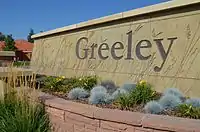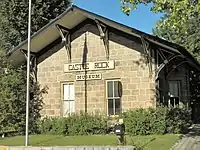Front Range Urban Corridor
The Front Range Urban Corridor is an oblong region of urban population located along the eastern face of the Southern Rocky Mountains, encompassing 18 counties in the US states of Colorado and Wyoming. The corridor derives its name from the Front Range, the mountain range that defines the western boundary of the corridor which serves as a gateway to the Rocky Mountains. The region comprises the northern portion of the Southern Rocky Mountain Front geographic area, which in turn comprises the southern portion of the Rocky Mountain Front geographic area of Canada and the United States. The Front Range Urban Corridor had an estimated population of 4,976,781 on July 1, 2018, an increase of +14.84% since the 2010 United States Census.[1] It is estimated that the population exceeded 5 million in 2019. Roughly 98% of the population within the entire urban corridor region is within Colorado and roughly 85% of Colorado's population resides within the urban corridor region.
Front Range Urban Corridor | |
|---|---|
 | |
 The Colorado State Capitol in Denver | |
 | |
| Country | |
| Encompassing states | |
| Population (July 1, 2018) | 4,976,781 |
Extent
The Front Range Urban Corridor stretches from Pueblo, Colorado, north along Interstate 25 to Cheyenne, Wyoming, and includes the Denver-Aurora-Lakewood, CO Metropolitan Statistical Area, the Colorado Springs, CO Metropolitan Statistical Area, the Boulder, CO Metropolitan Statistical Area, the Fort Collins, CO Metropolitan Statistical Area, the Greeley, CO Metropolitan Statistical Area, the Pueblo, CO Metropolitan Statistical Area, the Cheyenne, WY Metropolitan Statistical Area, and the Cañon City, CO Micropolitan Statistical Area. The corridor comprises three primary subregions: the South Central Colorado Urban Area, the North Central Colorado Urban Area, and the Cheyenne Metropolitan Area.
The influence of the Corridor extends well beyond its defined boundaries. The Colorado Eastern Plains, Nebraska Panhandle, and Albany County, Wyoming, among other areas, are culturally and economically tied to the Corridor, though they are not considered to be a part of it.
The definition included here is not used for the greater Front Range Megaregion, one of the 11 megaregions of the United States. The megaregion's area is more expansive, extending south from Pueblo along the I-25 corridor into New Mexico, including Albuquerque and Santa Fe, and also including the Wasatch Front of Utah, separated by hundreds of miles from the regional core.[2]
Metropolitan areas
The table below includes the following information:
- The urban region.
- The Core Based Statistical Area (CBSA) as designated by the United States Office of Management and Budget.[3]
- The CBSA population as of July 1, 2018, as estimated by the United States Census Bureau.[1]
- The county.[1]
- The county population as of July 1, 2018, as estimated by the United States Census Bureau.[1]
- The county population as of April 1, 2010, as enumerated by the 2010 United States Census.[1]
- The percent county population change from April 1, 2010, to July 1, 2018.[1]

Municipalities
Wyoming jurisdictions
In the State of Wyoming, the Front Range Urban Corridor includes the Town of Albin, the Town of Burns, the City of Cheyenne, the Town of Pine Bluffs, and unincorporated Laramie County.
Colorado jurisdictions
In the State of Colorado, the Front Range Urban Corridor includes:
- Town of Alma
- City of Arvada
- Town of Ault
- City of Aurora
- Town of Bennett
- Town of Berthoud
- City of Black Hawk
- Town of Boone
- City of Boulder
- Town of Bow Mar
- City of Brighton
- Town of Brookside
- City and County of Broomfield
- Town of Calhan
- City of Cañon City
- City of Castle Pines North
- Town of Castle Rock
- City of Centennial
- Central City
- City of Cherry Hills Village
- Town of Coal Creek
- City of Colorado Springs
- Town of Columbine Valley
- City of Commerce City
- City of Cripple Creek
- City of Dacono
- Town of Deer Trail
- City and County of Denver
- Town of Eaton
- City of Edgewater
- Town of Elizabeth
- Town of Empire
- City of Englewood
- Town of Erie
- Town of Estes Park
- City of Evans
- Town of Fairplay
- City of Federal Heights
- Town of Firestone
- City of Florence
- City of Fort Collins
- City of Fort Lupton
- City of Fountain
- Town of Foxfield
- Town of Frederick
- Town of Garden City
- Town of Georgetown
- Town of Gilcrest
- City of Glendale
- City of Golden
- City of Greeley
- Town of Green Mountain Falls
- City of Greenwood Village
- Town of Grover
- Town of Hudson
- City of Idaho Springs
- Town of Jamestown
- Town of Johnstown
- Town of Keenesburg
- Town of Kersey
- Town of Kiowa
- Town of La Salle
- City of Lafayette
- Town of Lakeside
- City of Lakewood
- Town of Larkspur
- City of Littleton
- Town of Lochbuie
- City of Lone Tree
- City of Longmont
- City of Louisville
- City of Loveland
- Town of Lyons
- City of Manitou Springs
- Town of Mead
- Town of Milliken
- Town of Monument
- Town of Morrison
- Town of Mountain View
- Town of Nederland
- City of Northglenn
- Town of Nunn
- Town of Palmer Lake
- Town of Parker
- Town of Pierce
- Town of Platteville
- City of Pueblo
- Town of Ramah
- Town of Raymer
- Town of Rockvale
- Town of Rye
- Town of Severance
- City of Sheridan
- Town of Silver Plume
- Town of Simla
- Town of Superior
- City of Thornton
- Town of Timnath
- City of Victor
- Town of Ward
- Town of Wellington
- City of Westminster
- City of Wheat Ridge
- Town of Williamsburg
- Town of Windsor
- City of Woodland Park
- unincorporated Adams County
- unincorporated Arapahoe County
- unincorporated Boulder County
- unincorporated Clear Creek County
- unincorporated Douglas County
- unincorporated El Paso County
- unincorporated Elbert County
- unincorporated Fremont County
- unincorporated Gilpin County
- unincorporated Jefferson County
- unincorporated Larimer County
- unincorporated Park County
- unincorporated Pueblo County
- unincorporated Teller County
- unincorporated Weld County
Gallery of the most populous Front Range municipalities
 1. The Denver Art Museum in Denver.
1. The Denver Art Museum in Denver. 2. Colorado Springs from the northeast.
2. Colorado Springs from the northeast. 3. The University of Colorado Hospital in Aurora.
3. The University of Colorado Hospital in Aurora. 4. Downtown Fort Collins.
4. Downtown Fort Collins. 5. The Lakewood Civic Center in Lakewood.
5. The Lakewood Civic Center in Lakewood. 6. Thornton welcome sign from Interstate 25.
6. Thornton welcome sign from Interstate 25. 7. Westminster Castle in Westminster.
7. Westminster Castle in Westminster. 8. Downtown Pueblo.
8. Downtown Pueblo. 9. The Arvada Flour Mill Museum in Arvada.
9. The Arvada Flour Mill Museum in Arvada. 10. The Dry Creek Station in Centennial.
10. The Dry Creek Station in Centennial. 11. The National Center for Atmospheric Research in Boulder.
11. The National Center for Atmospheric Research in Boulder. 12. Downtown Greeley.
12. Downtown Greeley. 13. The Longmont Safety and Justice Center in Longmont.
13. The Longmont Safety and Justice Center in Longmont. 14. The Budweiser Events Center in Loveland.
14. The Budweiser Events Center in Loveland. 15. The Wyoming State Capitol in Cheyenne.
15. The Wyoming State Capitol in Cheyenne. 16. The Interlocken Office Park in Broomfield.
16. The Interlocken Office Park in Broomfield. 17. The Castle Rock Depot in Castle Rock.
17. The Castle Rock Depot in Castle Rock.
See also
- Southern Rocky Mountain Front
- Front Range Urban Corridor
- Colorado
- Wyoming
- Conurbation
- List of census-designated places in Colorado
- List of census-designated places in Wyoming
- List of cities and towns in Colorado
- List of cities and towns in Wyoming
- List of counties in Colorado
- List of counties in Wyoming
- List of places in Colorado
- Megaregions of the United States
- Rocky Mountain Front
- Southern Rocky Mountains
- United States statistical area
- List of combined statistical areas
- List of core-based statistical areas
- List of metropolitan statistical areas
- List of micropolitan statistical areas
- List of primary statistical areas
References
- "Estimates of the Components of Resident Population Change for Counties: April 1, 2010 to July 1, 2018". 2018 Population Estimates. United States Census Bureau, Population Division. July 1, 2018. Archived from the original on February 13, 2020. Retrieved June 8, 2019.
- "Megaregions". Retrieved October 1, 2014.
- "OMB Bulletin No. 10-02: Update of Statistical Area Definitions and Guidance on Their Uses" (PDF). United States Office of Management and Budget. December 1, 2009. Archived from the original (PDF) on March 16, 2012. Retrieved May 5, 2011.
- The City of Centennial, Colorado was incorporated on February 7, 2001.

